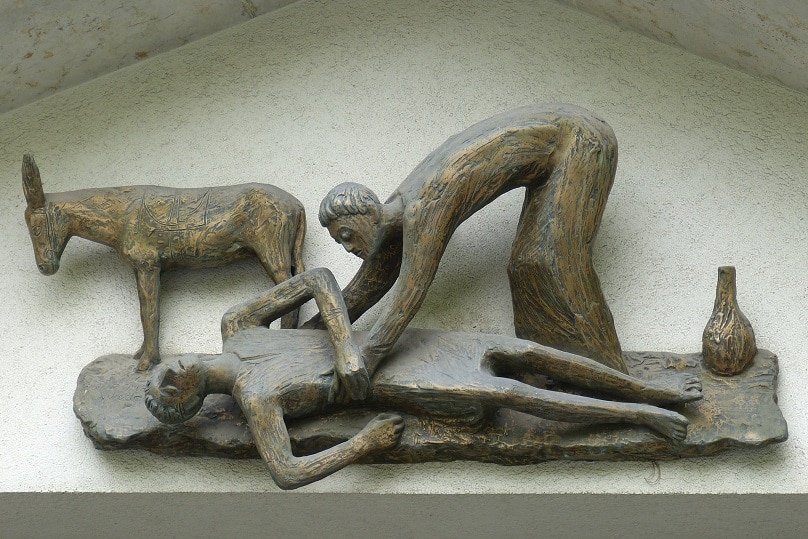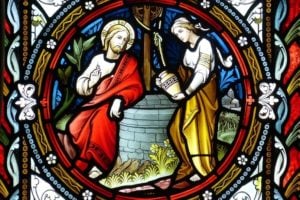
When most people hear the word ‘Samaritan’, they think of The Good Samaritan, rather than the not-so-good one of today’s Gospel. At first glance the two are unconnected by anything but nationality. The Good Samaritan appears only in Luke’s Gospel (Lk 10:25-37) and the Samaritan Woman at the Well only in John’s (Jn ch. 4). One is a man, the other a woman. One is fictitious, the other a real-life figure whom Jesus encountered. One gives, while the other receives. One stands for Jesus, while the other resists Him, at least to begin with. To look for more in common between them might be like those you meet in Europe or America who, on learning you are an Australian, say they know someone from Perth and presume you know them too and maybe are related to them … Yet for all the differences I want to suggest today there are more than geographic reasons for associating the Samaritan woman and man.
Our Gospel today opens with the woman’s surprise that Jesus would ask her for water. After all, the mountainous region on the borders of the Northern Kingdom of Israel may have been captured by the Israelites from the Canaanites and long associated with the tribes of Ephraim and Manasseh; but for centuries it had fallen under the sway of the Assyrians and others, suffering many conquests, deportations and resettlements. The Samaritans were therefore a population of mixed race and mixed-up religion. After the Babylonian captivity, the Jerusalem Jews were unwilling to involve the Samaritans in the rebuilding of the Temple, as by then they did not consider them real Jews any longer. Centuries of bitter rivalry between these close relatives ensued and by Jesus’ time Jews would not even use Samaritan utensils, as they were considered unclean. For Jesus the Jew to speak to a Samaritan, let alone ask one for assistance, was remarkable; to speak to one who was a stranger, a woman of low moral reputation, and unaccompanied by her latest ‘husband’, was even more so; but for a holy man to render Himself ritually impure by drinking from such a person’s ladle would have been scandalous.
So the woman is surprised. But this occasions one of the greatest interchanges in the whole of the Gospels, as a disciple-in-the-making learns about faith, baptism and salvation – the ‘living water’, welling up to eternal life – about true worship of God “in spirit and truth” and, above all, about the Man who was in front of her, whom she calls at first ‘you Jew’, then ‘Sir’, then ‘Sir prophet’, and finally ‘the Christ’. That such an interchange could occur between a Jew and Samaritan was remarkable. But, then, when the very same Jew was earlier asked ‘Who is my neighbour?’, He had given us the wonderful story of The Good Samaritan as His answer.
Much of Jesus’ preaching was about expanding our notion of who is in our in-group and critiquing our notion of who are outsiders: we should interact with and help those of other tribes, He says; we should invite even the outcast into our circle, and so into God’s kingdom; we should give, forgive, turn the other cheek, love even our enemies, loving as Jesus loved us, even unto death … Bit by bit Jesus expands our notion of who are potential siblings and friends to us, until no one is left outside the tent of those for whom the Christian holds out hope and love. Jesus gradually reveals that while “salvation comes from the Jews” it is not for them only: He came to make all humanity the new Israel, to make all the children of God.

Which is why the early Church felt compelled to reach beyond Israel, opening its arms wider and wider, all the way to Rome and ultimately to Botany Bay. For as St Paul pointed out in our Epistle, whether Jews or Gentiles we were all sinners when Christ died for us (Rom 5:8). This is what makes us neighbours, what makes us recognise each other as brothers and sisters: that none of us deserved ‘the Jew-Prophet-Christ’, but all of us equally needed Him. We are the mugged man on the Damascus Road and the thirsty woman at Jacob’s well, brethren in our sheer neediness before God and dependence upon those around us. In Lent we remember this by reaching out to those most in need of our extra prayer, self-denial and works of mercy, those desperate to be received as our neighbours and to have their needs addressed by us (Mt 25:35-40), whether it is their physical needs as in the story of the Samaritan man or their spiritual needs as in the story of the Samaritan woman.
Which brings me to a second point of contact between the two Samaritan stories: in Luke’s Good Samaritan the traveller, who we might say represents Christ, encounters someone in desperate physical need and nurses him; in John’s Becoming-Good Samaritan the traveller is certainly Christ and He confronts someone in desperate spiritual need and serves her. In both cases the response is immediate, instinctive, non-discriminatory towards Jew, Gentile and halfway-house Samaritan. We are neighbours, then, and siblings, not just in our neediness but in the response of the Good Jew and Good Samaritan to our need: we have both been saved.
Which brings me to the third connection between our two Samaritan stories: the call to the needy-but-saved to engage in turn in peer-to-peer ministry. This is, of course, the story of the Church: for the Church is bashed-up humanity, abandoned beside the road, desperate to be succoured by Christ; the Church is abashed humanity, thirsty, tired and ashamed beside the well, desperate to be taught by Him. St Augustine suggests we hear ourselves speaking in this woman at the well, and see in her an image of our need for salvation, of our receiving it and finally of our mediating it to others. Israel, liberated from external slavery but still tormented by internal thirst in our First Reading today, murmurs against God and Moses (Ex 17:3-7).
But the new Israel represented by our Samaritan woman, who is the Church, receives that which alone can quench our deepest desires and liberate us from what most oppresses us. She responds not with murmuring but with thanksgiving and, indeed, with sharing her story with others, as must the catechumens whose special Gospel this is in the lead up to Easter. As St John delights in telling us this morning, “Many Samaritans of that town came to believe in Jesus on the strength of the woman’s testimony”.
The two Samaritans, then, point to the needs of the whole human person, the needs of the body for the corporal works of mercy and the needs of the soul for the spiritual. If we truly love our neighbours we will seek to befriend them in both ways, quenching their thirsty flesh and equally thirsty spirits, housing their homeless bodies and churching their homeless souls. In Lent our neighbours cry out to join us in worshipping “in spirit and in truth”, that they might join those who said to the woman: “Now we no longer believe just because of what you told us: we have seen and heard Jesus for ourselves, and we know He is the Saviour of the world!”
This is the edited text of the homily by Archbishop Anthony Fisher OP at the Mass for the 3rd Sunday of Lent Year A, St Mary’s Cathedral, Sydney, 19 March 2017. Hyperlinks added by The Catholic Weekly and do not necessarily represent the views of the archbishop.
